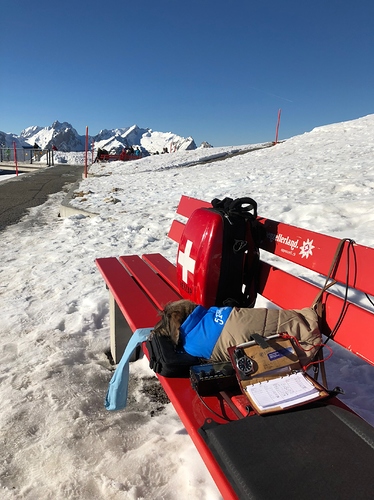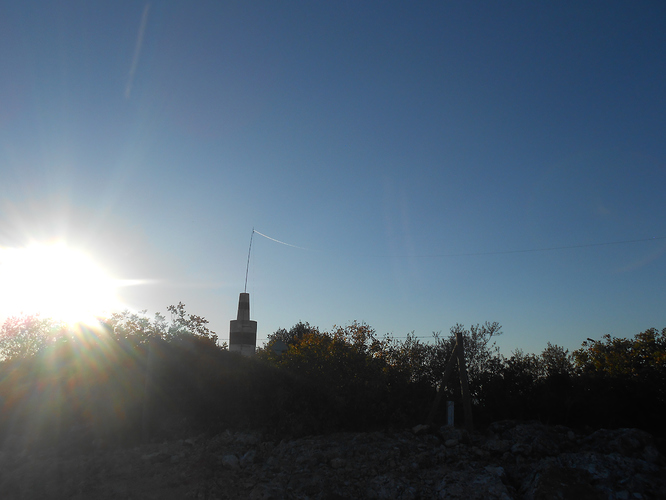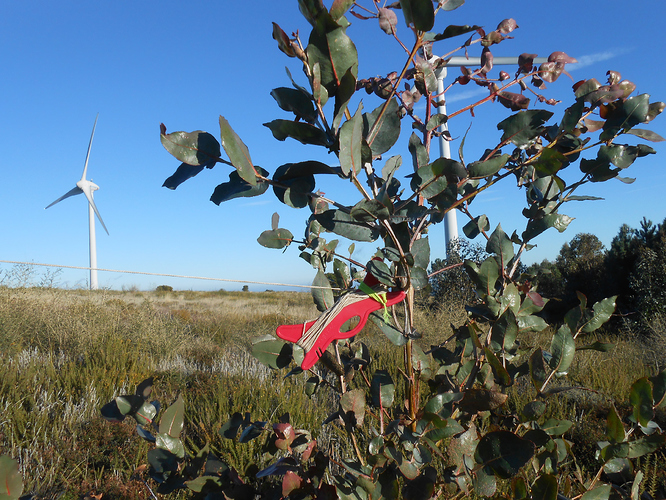Hi, i am operating. KX2, 10 W SSB, with variou antennasc, eg. AlexALoop, EF 20/40 m, CH Vertical with extension and Un-Un 9:1, upper/outer 5 m wire/ fishing -rod,
I notice practically no difference between these antennas, actual conditions matter, in my opinion, more then the typ of antennas. As an example I made a contact in Ssb from Switzerland to Australia, this is a rare exemption in my opinion.
Just keep on trying and experimenting, in my case, when I get the impression , that few Contact may be due to the wrong antenna, I select for the next activation an other typ of my antennas, the result my be better, but why this is the case, I don‘t know.
So if you are „Hercules“ carry all different antennas along, else consider Weight an use an Endfed wire and 5 m fishing rod.k
Ed. hb9zap
Yes. The spool of wire, roll out on a wire winder taken from a kite. The wire length is about 40m long (~130 ft) and I use the longest possible. Never had a problem with KX-2 (or KX-3) to tune the antenna.
Sometimes is use a L configuration but sometimes I don’t.
L configuration
Sloper
The wire winder
All wire in it
Note the plastic ring used to be sure there are no stress on the terminal
The last version of 9:1
Top antenna insulator (from SOTABeams) + keyring
Vy 73 de Pedro, CT1DBS/CU3HF
I dumped using 550 cord for portable ops a while back and go with this:
Rated 100lbs strength. And somewhere’s around here I do have an Atwood roll that says rated to 350lbs. Never tested, yet. ![]()
Works great…
Later,
Todd KH2TJ
Hi Barry
Sure. You could use RG-213 or RG-8… ![]() Less dB loss in the cable but a little bit more weight and not so manoeuvrable…
Less dB loss in the cable but a little bit more weight and not so manoeuvrable…
That’s why I bought the best RG-174 in the market. And tested it, of course.
I want a compromise between weight and functionality.
It works ? FB and move on to activate summits ASAP. ![]()
I agreed with Ed, HB9ZAP
73
If I can, I use a linked dipole. If I can’t use that, I’ll fall back to either a monoband vertical with elevated ground-plane, or to a 42ft end-fed wire (with counterpoise on the ground of about the same length) fed almost directly into the rig.
You can see this last lot in this thread → Stapellager Berge DM/NW-089 - #2 by M0LEP
You’ll notice there are two short lengths of coax. One is about a foot long and fitted with a right-angle BNC. The other has a ferrite choke, and is handy if RF starts to get back into the rig in un-wanted ways.
Hi Joe, you can’t go wrong with a SOTABeams band hopper linked dipole and a fibreglass fishing pole. You can even build the antenna yourself if you prefer (calculator is on the Sota Mapping Project website).
http://www.sotamaps.org/extras.php
I’m sure you will have - or will - get lots of other suggestions.
The linked dipole requires no ATU by the way.
My second choice would be a HF “J-pole” antenna but these are single band antennas but small, light and again need no tuner.
73 Ed DD5LP.
Dipoles and inverted Vees are hard to beat but harder to set up in the field. You might want to look at the 49:1 end fed half wave. This is a resonant end fed vs the random non-resonant 9:1 EARC. I’ve built and compared both on WSPR with an inverted Vee at the same height and the EARC was averaging about -6 dB across 10 stations in a 1 hour period. The 49:1 EFHW was about +3 dB over the inverted Vee but I think that might have been coax loss (~ 150 feet additional for the inverted Vee) and a lower takeoff angle of the sloper configured EFHW.
The 9:1 EARC is also pretty finicky… I could get decent results at home but when deployed for FD, it never worked very well. The 49:1 seems to work the same at home or in the field.
As an added bonus, since it’s a resonant antenna the 49:1 EFHW doesn’t require a tuner. I get a fairly flat SWR (1:1-2:1) on 40/20/15/10. SWR on 30m is around 3:1 so an internal can tune it or you could use a halfway length wire on 30m for better results.
73 Gene KJ4M
I was reading about these last night. Two questions:
- How long of a feed line do you run? Ie how far is it from the place the wires split back to your radio?
- How high do you generally elevate the ends of each end of the antenna?
The feed line is 28 feet. I split the wire to make the legs, then tied a simple overhand knot around a SotaBeams top insulator to keep it from pulling apart farther. I crimped and soldered some fork-shaped terminals (like this) at the end, which I screw onto a BNC to binding post adaptor which goes right to the KX3 (or tuner). Most of the time 28 feet is more than enough feed line, and some of it lies on the ground while I operate.
For the ends, I have two ropes that I use. I have not measured their lengths. If there is a tree or bush, I’ll tie the ends up as high as I can, but sometimes they are just staked to the ground. I have a pole that will get the center up about 17-18 feet, and I use that unless there is a convenient tree branch. I’ve found the KX3 rarely needs to retune for different setups.
Here you can see one of the legs tied to a fence, at the last post before it goes into the bushes. It is probably about waist high. The pole and other leg are similarly attached to the fence. (Barbed wire fences are great antenna supports) W6/NC-402
Here in a free-standing setup. There are three support ropes to hold up the pole, then the two legs staked to the ground. Mt Misery, W6/NC-197
If you peruse my blog, you can probably find more pictures of the various ways I’ve set up. In the end, simply being on a summit give you a huge advantage, so I don’t worry about eliminating every last fraction of a dB of loss.
Hi Gene,
what is the difference between a 49:1 and a typical 81:1 EFHW in terms of radiator length?
Martin
Hi Martin,
I’m not familiar with the 81:1 but that would transform 50 Ohms to about 4 kOhms. The EARC, (27T secondary/9T primary)^2 for a 9:1 impedance transform so 50 Ohms to 450 Ohms. The impedance at the end of a half wave dipole is roughly 2500 Ohms so the 49:1 (14T secondary/ 2T primary)^2 gets close (50 Ohms*49= 2450 Ohms).
Wire lengths that I used for the EARC were 31, 54 and 71 feet. I found a list of lengths online for these “random” lengths but they really aren’t random if you need to tune them…
For the 49:1 transformer, the same half wave dipole calculation can be used. I’ve tested ~33 ft for 20-10m, ~67 ft for 40-10m and ~134 ft for 80-10m length wire with good results.
Gene
I haven’t done it, but I imagine deploying a 20m radiator (40m is essentialf or me) on a summit around here would be tough. Many/most are densely tree covered.
Good point. I do like the shorter wire
I use a KX-2 + 9:1- UNUN + LW.
No coax between. LW so long as possible on the summit.
Supported by 5m high fishing pole close to the trcvr. Counterpose abt 3 m.
Maybe the UNUN is not necessary, but its use showed better results during test transmissions on RBN
73!
Andy/DL6AP
What do you use for a feed line?
No feed line, I connect the antenna wire directly with the UNUN @ banana plug hi.
That would definitely be my opinion in your case - the external 9:1 is extraneous and adds slight amount of loss, no matter what RBN seems to be saying. But if you enjoy using it, go for it.
73, Barry N1EU
If this is true, would this be a fair statement?
“Running an antenna and counterpoise directly from the BNC jack (via a wire adapter) is always going to be more efficient than the coax+9:1unun setup. In other words, you’re trading the operating ease afforded by the coax for the losses of the coax and transformer.”
I think it’s basically true although it’s possible that using a 9:1 and length of coax will allow you to elevate the end of the radiator and give slightly better performance in that regard. That plus eliminating the need to run a separate counterpoise wire are its possible advantages.
The same setup I use, 9:1 UNUN, 58’ radiator and 13’ ground and it indeed does tune 80 -10. I don’t use over 15’ feedline, sometimes less depending on circumstances and it is RG-58 and have never been bitten by RF.


